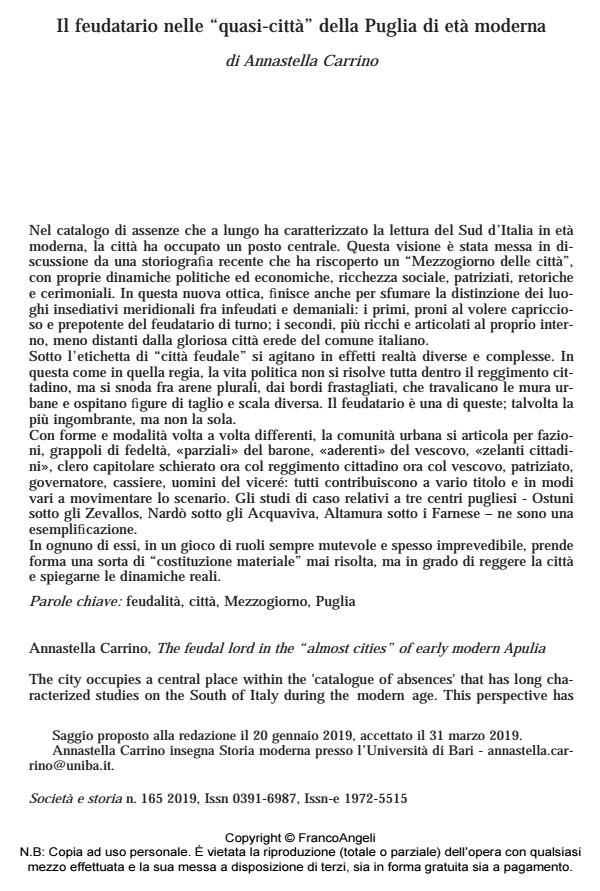The feudal lord in the "almost cities" of early modern Apulia
Journal title SOCIETÀ E STORIA
Author/s Annastella Carrino
Publishing Year 2019 Issue 2019/165 Language Italian
Pages 20 P. 503-522 File size 76 KB
DOI 10.3280/SS2019-165007
DOI is like a bar code for intellectual property: to have more infomation
click here
Below, you can see the article first page
If you want to buy this article in PDF format, you can do it, following the instructions to buy download credits

FrancoAngeli is member of Publishers International Linking Association, Inc (PILA), a not-for-profit association which run the CrossRef service enabling links to and from online scholarly content.
The city occupies a central place within the 'catalogue of absences' that has long characterized studies on the South of Italy during the modern age. This perspective has been challenged by recent historiography, which has rediscovered a "Mezzogiorno of the cities", with its own political and economic dynamics, social wealth, patriciates, rhetoric and ceremonies. From this new perspective, the gap between fiefdoms and post-feudal political entities in southern townships begins to close. The former were subject to the capricious and arrogant rule of the incumbent feudal lord. The latter were richer, better structured internally, and closer to the glorious city that was the successor to the Italian commune. Diverse and complex realities coexist under the label of "feudal city2. In this, as in cities within kingdoms, political life is not confined to its rulers, but is spread across multiple areas with porous edges that go beyond urban walls and accommodate people of different calibre and social standing. The feudal lord can be counted among them: sometimes he is the most troublesome, but he is not alone in this. The urban community (sometimes in different forms and modes) is organized into factions, loyal groups, 'favourites' of the baron, "followers" of the bishop, zealous citizens, a diocesan chapter (siding sometimes with the civic authorities and sometimes with the local bishop), the patriciate, the governor, the treasurer, the viceroy’s men. All contribute (for different reasons and in various ways) to keep the show on the road. An illustration of this can be observed in case studies relating to three Apulian centres - Ostuni (under the Zevallos family), Nardò (under the Acquaviva family), and Altamura (under the Farnese family). In each of them, in a game where roles are constantly changing and often unpredictable, a kind of "unwritten constitution" takes shape, never resolved but capable of ruling the city and eliciting the real dynamics therein.
Keywords: Feudalism, Town, South of Italy, Apulia
- Anglani A. (1909), Gli Amleti di Ostuni, Ostuni, Tamborrino.
- Biscozzi R. (2015), Dalla parte dei giusti. La rivolta del 1647 a Nardò descritta dall’abate Biscozzi, a cura di A. Palumbo, Fondazione Terra d’Otranto, Lecce.
- Calculli L. (2012), La città e il Duca: Altamura farnesiana tra Cinque e Seicento, tesi di dottorato in Storia dell’Europa moderna e contemporanea, ciclo XXIV.
- Candida Gonzaga B. (1965), Memorie delle famiglie nobili delle provincie meridionali d’Italia, Bologna, Forni (rist. anast. dell’edizione di Napoli, 1875).
- Capecelatro, F. (1850-54), Diario di Francesco Capecelatro contenente la storia delle cose avvenute nel Reame di Napoli negli anni 1647-1650, Napoli.
- Carrino A. (2006), Città, patriziati, fazioni: la politica locale nel Mezzogiorno spagnolo: tre studi di caso, in «Società e storia», n. 113, pp. 559-598.
- Carrino A. (2017), Quasi sint civitates. Società, poteri e rappresentazioni nella Puglia di età moderna, Roma, Aracne.
- Confuorto D. (1639), Notizie d’alcune famiglie popolari della città e Regno di Napoli, divenute ragguardevoli per ricchezza o per dignitadi, ms.
- De Rose A. (2001), I palazzi di Napoli, Roma, Newton & Compton.
- Di Tarsia P.A. (1694), Historia Cupersanensium, Mantual.
- Lospalluto F. (a cura di), (1956), Libro rosso e libro magno di Altamuura, in «Altamura », n. 5, 1956.
- Martino A. (2012), Giovan Girolamo II Acquaviva d’Aragona (1604c.-1665): signore feudale del Mezzogiorno spagnolo, tesi di dottorato di ricerca, Universidad de Valladolid.
- Masi G. (1956), Altamura farnesiana, Bari, Cressati.
- Musi A. (1976), Finanze e politica nella Napoli del Seicento: Bartolomeo D’Aquino, Napoli, Guida.
- Palmieri F. (2018), Le llamaban Rey de la Pulla. Giangirolamo II Acquaviva d’Aragona e il ducato di Nardò, Global Thesys in Scienze Storiche e della documentazione storica, Dipartimento di Studi Umanistici, Università degli studi di Bari) – Universidad de Cantabria, a.a. 2017-18.
- Pacichelli G. B. (1703), Il regno di Napoli in prospettiva diviso in dodeci province, vol. II, Napoli.
- Pepe L. (1908), Ostuni sotto i duchi Zevallos, in «Rassegna Pugliese», pp. 117-120.
- Pepe L. (1962), Nardò e Terra d’Otranto nei moti del 1647-48, Manduria-Bari-Perugia, Lacaita, II ed.
- Pepe L. (2001), Storia della città di Ostuni dal 1463 al 1639, in Id., Storia della città di Ostuni dalle origini al 1806, a cura di A. Minna, M.A. Moro, A.M. Tanzarella, Manduria, Lacaita (ed. orig. Trani 1894).
- Rizzo L.G. (1936), Le strane pretese del Duca Bartolomeo de Zevallos contro il Clero di Ostuni (1701-1703), Lecce, la Modernissima.
- Villari R. (2012), Un sogno di libertà. Napoli nel declino di un impero, Milano, Mondadori.
- Quale storia della società? Uno sguardo sull'epoca moderna Paola Bianchi, in SOCIETÀ E STORIA 178/2023 pp.711
DOI: 10.3280/SS2022-178005
Annastella Carrino, Il feudatario nelle "quasi-città" della Puglia di età moderna in "SOCIETÀ E STORIA " 165/2019, pp 503-522, DOI: 10.3280/SS2019-165007